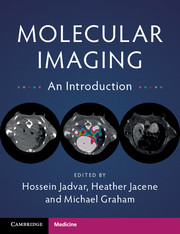Book contents
- Frontmatter
- Contents
- List of Contributors
- Preface
- 1 Instrumentation – CT
- 2 MRI/ MRS Instrumentation and Physics
- 3 Optical and Ultrasound Imaging
- 4 Instrumentation-Nuclear Medicine and PET
- 5 Quantitation-Nuclear Medicine
- 6 Perfusion
- 7 Metabolism
- 8 Cellular Proliferation
- 9 Hypoxia
- 10 Receptor Imaging
- 11 Apoptosis
- 12 Angiogenesis
- 13 Reporter Genes
- 14 Stem Cell Tracking
- 15 Amyloid Imaging
- Index
- References
11 - Apoptosis
Published online by Cambridge University Press: 22 November 2017
- Frontmatter
- Contents
- List of Contributors
- Preface
- 1 Instrumentation – CT
- 2 MRI/ MRS Instrumentation and Physics
- 3 Optical and Ultrasound Imaging
- 4 Instrumentation-Nuclear Medicine and PET
- 5 Quantitation-Nuclear Medicine
- 6 Perfusion
- 7 Metabolism
- 8 Cellular Proliferation
- 9 Hypoxia
- 10 Receptor Imaging
- 11 Apoptosis
- 12 Angiogenesis
- 13 Reporter Genes
- 14 Stem Cell Tracking
- 15 Amyloid Imaging
- Index
- References
Summary
The Apoptosis Cellular Pathway
Apoptosis is the process of programmed cell death and is critical for growth and development and the maintenance of cellular homeostasis. Cells committed to death through the apoptotic pathway are dissembled according to a coordinated sequence of events. The classic morphologic changes during apoptosis are loss of communication and detachment from neighboring cells, condensation of chromatin at the nuclear membrane, fragmentation of the nuclear membrane, cell shrinkage, and formation of apoptotic bodies which are subsequently phagocytosed. Apoptosis is energy dependent and a distinct feature is that the cell's plasma membrane remains intact. There is no accompanying inflammatory response and no evidence of the cell's previous existence. In contrast, cellular necrosis is a disorderly process which results in surrounding inflammation and oftentimes residual tissue scarring.
Apoptosis is mediated through a number of cellular proteins and signaling pathways (Figure 11.1). The major family of proteins responsible for apoptosis is cysteine proteases called caspases. Caspases are inactivated in the cell cytoplasm (as procaspases) until receiving a death signal. Once activated, initiator caspases activate effector caspases which in turn activate the rest of the machinery needed for programmed cell death. Activation of the initiator caspases occurs via the intrinsic or mitochondrial pathway or via the extrinsic pathway.
The intrinsic (mitochondrial) pathway is induced by cellular stress or the loss of survival signals. Upon receiving such signals, mitochondria release cytochrome c through pores in the mitochondrial membrane causing apoptosome formation through oligomerization of molecules, Apaf-1 in vertebrates. Apoptosome formation results in activation of initiator caspases. The Bcl-2 family of proteins regulates the mitochondrial pathway through both anti-apoptotic (e.g., Bcl-2) and pro-apoptotic (e.g., Bak, Bax) properties.
The extrinsic pathway is activated by the binding of death ligands (e.g., tumor necrosis factor alpha) to the extracellular component of death receptors in the cell membrane. This results in the recruitment of adaptor molecules which activate initiator caspases. Subsquent formation of death receptor signaling complexes activates effector caspases leading to apoptosis. An immune response or tumorigenesis can initiate the extrinsic pathway.
- Type
- Chapter
- Information
- Molecular ImagingAn Introduction, pp. 47 - 51Publisher: Cambridge University PressPrint publication year: 2017



